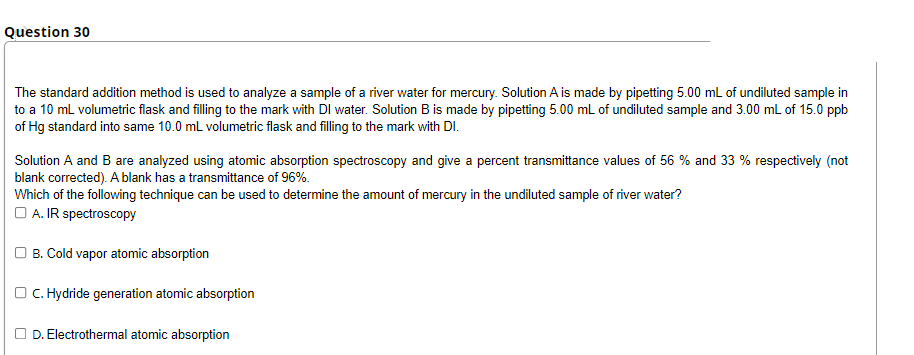The standard addition method is used to analyze a sample of a river water for mercury. Solution A is made by pipetting 5.00 mL of undiluted sample in to a 10 ml volumetric flask and filling to the mark with DI water. Solution B is made by pipetting 5.00 mL of undiluted sample and 3.00 mL of 15.0 ppb of Hg standard into same 10.0 mL volumetric flask and filling to the mark with DI. Solution A and B are analyzed using atomic absorption spectroscopy and give a percent transmittance values of 56 % and 33 % respectively (not blank corrected). A blank has a transmittance of 96%. Which of the following technique can be used to determine the amount of mercury in the undiluted sample of river water? O A. IR spectroscopy O B. Cold vapor atomic absorption OC. Hydride generation atomic absorption O D. Electrothermal atomic absorption
The standard addition method is used to analyze a sample of a river water for mercury. Solution A is made by pipetting 5.00 mL of undiluted sample in to a 10 ml volumetric flask and filling to the mark with DI water. Solution B is made by pipetting 5.00 mL of undiluted sample and 3.00 mL of 15.0 ppb of Hg standard into same 10.0 mL volumetric flask and filling to the mark with DI. Solution A and B are analyzed using atomic absorption spectroscopy and give a percent transmittance values of 56 % and 33 % respectively (not blank corrected). A blank has a transmittance of 96%. Which of the following technique can be used to determine the amount of mercury in the undiluted sample of river water? O A. IR spectroscopy O B. Cold vapor atomic absorption OC. Hydride generation atomic absorption O D. Electrothermal atomic absorption
Chemistry
10th Edition
ISBN:9781305957404
Author:Steven S. Zumdahl, Susan A. Zumdahl, Donald J. DeCoste
Publisher:Steven S. Zumdahl, Susan A. Zumdahl, Donald J. DeCoste
Chapter1: Chemical Foundations
Section: Chapter Questions
Problem 1RQ: Define and explain the differences between the following terms. a. law and theory b. theory and...
Related questions
Question

Transcribed Image Text:Question 30
The standard addition method is used to analyze a sample of a river water for mercury. Solution A is made by pipetting 5.00 mL of undiluted sample in
to a 10 mL volumetric flask and filling to the mark with DI water. Solution B is made by pipetting 5.00 mL of undiluted sample and 3.00 mL of 15.0 ppb
of Hg standard into same 10.0 mL volumetric flask and filling to the mark with DI.
Solution A and B are analyzed using atomic absorption spectroscopy and give a percent transmittance values of 56 % and 33 % respectively (not
blank corrected). A blank has a transmittance of 96%.
Which of the following technique can be used to determine the amount of mercury in the undiluted sample of river water?
O A. IR spectroscopy
O B. Cold vapor atomic absorption
OC. Hydride generation atomic absorption
D. Electrothermal atomic absorption
Expert Solution
This question has been solved!
Explore an expertly crafted, step-by-step solution for a thorough understanding of key concepts.
Step by step
Solved in 2 steps

Knowledge Booster
Learn more about
Need a deep-dive on the concept behind this application? Look no further. Learn more about this topic, chemistry and related others by exploring similar questions and additional content below.Recommended textbooks for you

Chemistry
Chemistry
ISBN:
9781305957404
Author:
Steven S. Zumdahl, Susan A. Zumdahl, Donald J. DeCoste
Publisher:
Cengage Learning

Chemistry
Chemistry
ISBN:
9781259911156
Author:
Raymond Chang Dr., Jason Overby Professor
Publisher:
McGraw-Hill Education

Principles of Instrumental Analysis
Chemistry
ISBN:
9781305577213
Author:
Douglas A. Skoog, F. James Holler, Stanley R. Crouch
Publisher:
Cengage Learning

Chemistry
Chemistry
ISBN:
9781305957404
Author:
Steven S. Zumdahl, Susan A. Zumdahl, Donald J. DeCoste
Publisher:
Cengage Learning

Chemistry
Chemistry
ISBN:
9781259911156
Author:
Raymond Chang Dr., Jason Overby Professor
Publisher:
McGraw-Hill Education

Principles of Instrumental Analysis
Chemistry
ISBN:
9781305577213
Author:
Douglas A. Skoog, F. James Holler, Stanley R. Crouch
Publisher:
Cengage Learning

Organic Chemistry
Chemistry
ISBN:
9780078021558
Author:
Janice Gorzynski Smith Dr.
Publisher:
McGraw-Hill Education

Chemistry: Principles and Reactions
Chemistry
ISBN:
9781305079373
Author:
William L. Masterton, Cecile N. Hurley
Publisher:
Cengage Learning

Elementary Principles of Chemical Processes, Bind…
Chemistry
ISBN:
9781118431221
Author:
Richard M. Felder, Ronald W. Rousseau, Lisa G. Bullard
Publisher:
WILEY